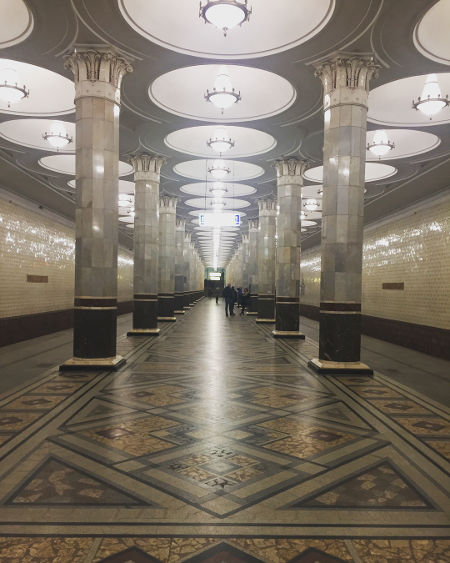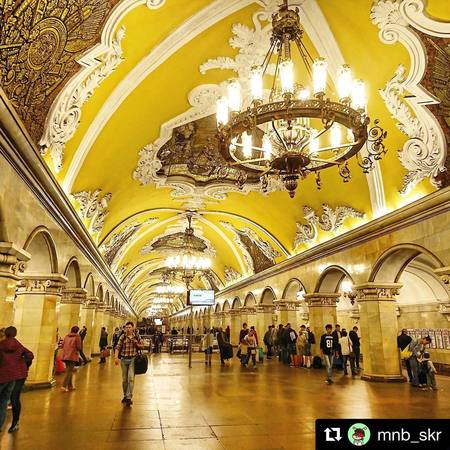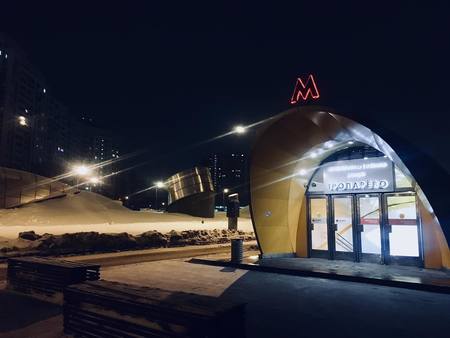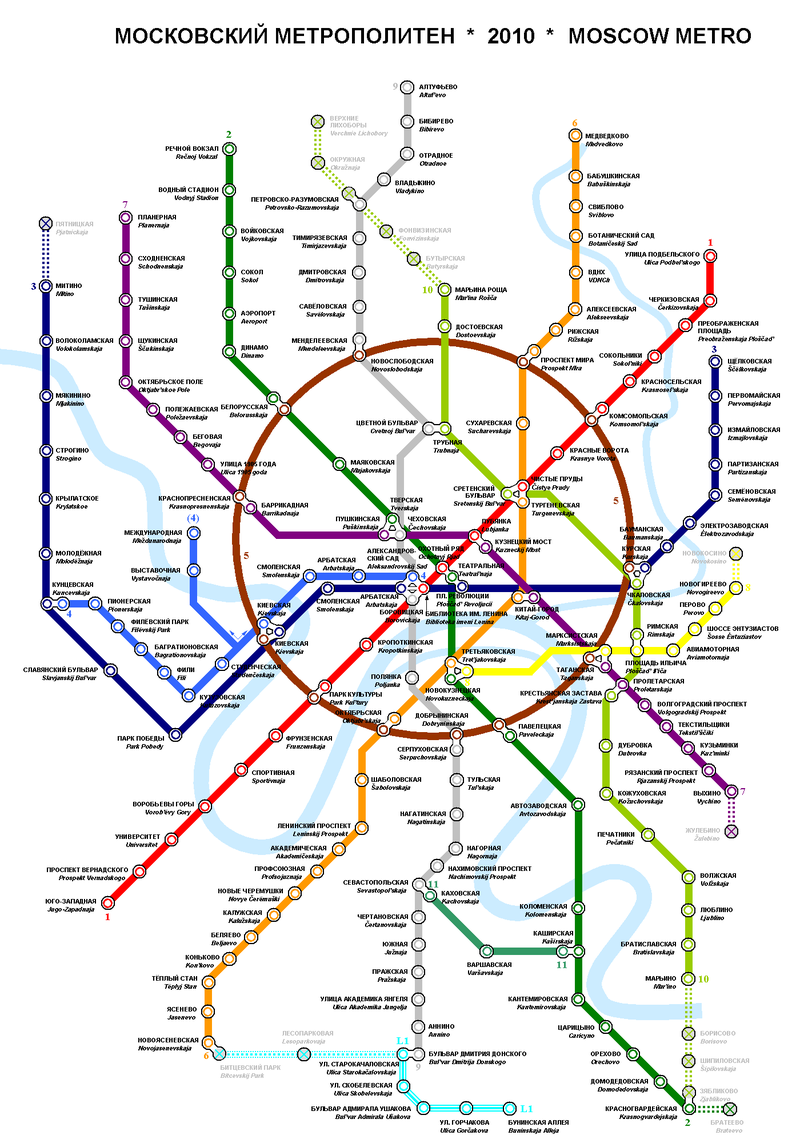Moscow’s 14 line metro system is in constant expansion. Its regular metro schedule runs from 5:30 am to 1:00 am and operates at a high frequency. Single tickets can be used although using a Troika card is most recommended. The price of a single fare card is 55 rubles (US $0.97). Any of Moscow’s 3 airports are accessible by bus and metro and the metro is famous for the murals, mosaics, candelabras, and art that fill its stations.
Transport in Russia: Moscow Metro
Moscow runs with a large network of Metro lines that provide service to most of the city in conjunction with other transportation options (including buses, trains, and trams) allowing travel to any part of the city.
This system’s stations are famous for being some of the most beautiful in the world. They feature murals, mosaics, candelabras and other artistic motifs that show the evolution of Russian ideas throughout time.
Moscow’s metro system doesn’t have a clearly defined logo, but the stations are labeled with an uppercase “M”. Each station is named after a letter in the Russian alphabet, but inside of each station and on the metro you will find maps with names in both the Russian alphabet and the Latin alphabet.
History
Unlike many of the world’s other metro systems that surged due to the necessity for a fast and efficient mode of transportation, the history of Moscow’s metro is also tied to the politics and ideas that shaped Russian society.
The metro is more than just a transportation system. It’s a symbol of national pride, representing how the technological capacity of this county has advanced as much as the culture and society.
Although it is known that plans existed for metro construction during the time of Imperial Russia, the First World War and various civil wars meant the first metro line would not begin to run until May 15, 1935 during Stalin’s rule.
 Moscow Metro
Moscow Metro
The metro was then seen as a show of the Soviet Union’s superiority over capitalistic societies. From this date onwards the metro was expanded and various lines were created with the idea that the stations represented the ideas of the Russian aesthetic, above all, the idea of ”splendor” and of a “brilliant future”, which explains the abundance of reflective murals and candelabras.
During the cold war, some stations were constructed with the intention of serving as a shelter in case of nuclear war. During this period, the grandiose style of the past was in part rejected in favor of more simple stations.
The art in these stations reflects the era in which they were created. The primary ones demonstrate the government’s intention to inspire the citizens’ appreciation for Soviet art. The stations that were constructed during the Second World War portrayed military motifs and the stations that came after the Cold War demonstrated a more reserved esthetic.
The present day Moscow metro is not only counted among some of the most beautiful, but it is also one of the most used systems in the world. Being that it is a truly efficient system, the system finds itself constantly expanding to meet the needs of Moscow’s residents.
Lines and Stations
Moscow’s metro system has 14 interconnected lines that allow passengers to travel to almost anywhere in the city. Each of these lines has a name, a code (numbers or numbers and letters) and a color. Despite being a complex and extensive system, these three things together make it easier to identify each line and to transfer from one line to another. Most of Moscow’s metro lines run below ground but there are also some surface and elevated stations.
Sokolnicheskaya Line
It is Moscow’s oldest metro line and runs from Bulvar Rokossovskogo to Salaryevo cutting halfway across the city on the northeast – southwest axis.
- Line color: Red
- Code: 1
- Number of stations: 22
- Length: 20.19 mi (32.5 km)
- Schedule: 5:00 am to 1:00 am
Zamoskvoretskaya Line
This line runs roughly diagonal through Moscow from north to south. Mayakovskaya is one of its most beautiful and more popular tourist stations.
- Line color: Dark green
- Code: 2
- Number of stations: 23
- Length: 20.19 mi (42 km)
- Schedule: 5:00 am to 1:00 am
Arbatsko-Pokrovskaya Line
This was the second line to operate and it is the longest metro line in all of Moscow. Its 22 stations run through Moscow from west to east. They connect to the Mitino District and they connect Krasnogorsk with the Moscow’s eastern suburbs.
- Line color: Dark blue
- Code: 3
- Number of stations: 22
- Length: 28.02 mi (45.1km)
- Schedule: 5:00 am to 1:00 am

Filyovskaya Line
Although most lines pass through Moscow from one end to another, this line leaves from the center of Moscow and connects with the Dorogomilovo and Fili districts to the west.
- Line color: Light blue
- Code: 4
- Number of stations: 13
- Length: 9.1 mi (14.7 km)
- Schedule: 5:00 am to 1:00 am
Koltsevaya Line
This is one of Moscow’s two metro lines that have a circular route. Its 12 stations run around the city from downtown. It is the most famous line since several stations still contain the famous Stalinist architecture.
- Line Color: Brown
- Code: 5
- Number of stations: 12
- Length: 12.05 mi (19.4 km)
- Schedule: 5:00 am a 1:00 am
Kaluzhsko–Rizhskaya Line
This line runs from one end of Moscow to the other from Medvedkovo to Novoyasenevskaya.
- Line Color: Orange
- Code: 6
- Number of stations: 24
- Length: 23.5 mi (37.8 km)
- Schedule: 5:00 am a 1:00 am
Tagansko–Krasnopresnenskaya Line
This 23 line station passes through Moscow from the northeast to the southeast and is the most used metro line.
- Line Color: Purple
- Code: 7
- Number of stations: 23
- Length: 26.1 mi (42 km)
- Schedule: 5:00 am a 1:00 am
Kalininsko–Solntsevskaya Line
This line is composed of two separated tracts that pass through the city from east to west. It is expected that both lines will be connected by 2020.
- Line Color: Yellow
- Code: 8 and 8a
- Number of stations: 8 and 5, respectively
- Length: 10.1 mi (16.3 km) and 6.6 mi (10.7 km), respectively
- Schedule: 5:00 am a 1:00 am

Serpukhovsko–Timiryazevskaya Line
This is Moscow’s second largest metro system. It passes from one end to another from Altufyevo to Bulvar Dmitriya Donskogo.
- Line Color: Gray
- Code: 9
- Number of stations: 25
- Length: 25.8 mi (41.5 km)
- Schedule: 5:00 am a 1:00 am
Lyublinsko–Dmitrovskaya Line
This line passes through Moscow from Seligerskaya to Krasnogvardeyskaya.
- Line Color: Light green
- Code: 10
- Number of stations: 20
- Length: 20.8 mi (33.4 km)
- Schedule: 5:00 am a 1:00 am
Kakhovskaya Line
Only 2.1 mi (3.3 km) long, this is the shortest line in Moscow’s metro system. It connects the gray line to the green line.
- Line Color: Aquamarine
- Code: 11A
- Number of stations: 3
- Length: 2.1 mi (3.3 km)
- Schedule: 5:00 am a 1:00 am
Butovskaya Line
This line can be considered as an extension of line 6. It extends to Buninskaya Alleya. It is not an underground line, but an elevated one.
- Line Color: Grayish blue
- Code: 12
- Number of stations: 7
- Length: 6.2 mi (10 km)
- Schedule: 5:00 am to 1:00 am
Monorail
In spite of being a monorail and not a metro, it is part of the metro system and the connection between the metro and monorail is free within 90 minutes.
- Line Color: Blue
- Code: 13
- Number of stations: 6
- Length: 2.3 mi (4.7 km)
- Schedule: 5:00 am a 1:00 am
Central Circle
This is the second circular route and its 31 stations surround all of what is considered historic Moscow.
- Line Color: White circle with a double red line
- Code: 14
- Number of stations: 31
- Length: 33.6 mi (54 km)
- Schedule: 5:00 am a 1:00 am
Schedules and Frequency
Most of Moscow’s metro stations open at 5:30 am and close their doors at 1:00 am. The monorail (Line 13) operates from 7:00 am to 11:00 pm and line 14 (Central Circle) operates from 5:45 am to 12:30 am. The metros on most lines run every 2 or 3 minutes most of the day and every 90 seconds during peak time. The metro runs from 6 to 10 minutes at night.
 Komsomolskaya
Komsomolskaya
Connections with other systems
14 of Moscow’s metro lines connect at various points along its route, making it easy to transfer comfortably from one line to another. Once your ticket has been validated, you can change between lines 1-12 without a time limit and without paying extra.
The connection from one of the 12 lines to line 13 (the monorail) and vice versa is free within 90 minutes from initial entry.
The connection from one of the 12 lines to line 14 (Central Circle) and vice versa is free within 90 minutes from initial entry.
Single metro tickets don’t include connections to other transportation systems such as buses or trams.
Troika Card
The Troika card is the most convenient payment method for transportation in Moscow. It consists of a plastic card that can be loaded with money and used on future purchases for any available ticket type.
The card requires a deposit of 50 rubles (US $0.88) that you can get back when returning the card. The Troika card is valid for 5 years and can be used on the metro as well as any of the other transportation systems. You can reload it at ticket windows in the stations, on machines or through the app.
Prices- Troika card: 50 rubles (US$0.88)
- A trip on the metro and monorail: 36 rubles (US$0.63)
- A trip on other modes of transportations: 36 rubles (US$0.63)
- 90 minute unlimited connections between metro and other modes of transportation: 56 rubles (US$0.99)
Single tickets:
If you do not wish to use a Troika card, you can purchase a single ticket or a ticket package that comes in the form of a red card. You can use this card on the metro as well as other modes of transportation such as buses and trams.
Prices- 1 trip (valid for 5 days from the day of purchase): 55 rubles (US$0.97)
- 2 trips (valid for 5 days from the day of purchase): 110 rubles (US$1.94)
- 20 trips (valid for 90 days from the day of purchase): 747 rubles (US$13.17)
- 40 trips (valid for 90 days from the day of purchase): 1494 rubles (US$26.34)
- 40 trips (valid for 90 days from the day of purchase and only available for purchase with the Troika card): 1765 rubles (US$31.12)
Unlimited trips
These passes have been given the name “Edinaya” and they permit unlimited travel during a specified period of time. You can begin using the passes for at least 30 days within 10 days from the time of purchase. The specified period will begin counting down from the first time the passes are used. Going forward, the 30 day passes can only be purchased through a Troika card and they are ready for use from the time of purchase.
Prices- 1 day: 218 rubles (US$3.84)
- 3 days: 415 rubles (US$7.32)
- 7 days: 830 rubles (US$14.63)
- 30 days: 2075 rubles (US$36.58)
- 90 days: 5190 rubles (US$91.5)
- 365 days: 18900 rubles (US$333.21)
Tips:
- Although Moscow’s metro system can seem complicated with its 14 lines, planning a trip is easy thanks to the interactive map on its official web page and app.
- Purchasing single tickets costs less than buying a Troika card.
- If you have money loaded on your Troika card and you are going to leave the country, you can go to any one of the metro’s main offices and request a refund for as much money that is available on the card including the deposit.
- The maps inside the stations and metros show the stations in both the Russian alphabet and the Latin alphabet.
- The app Yandex.Metro offers bilingual maps and allows you to plan your trip, estimating travel time and factoring in the connections you have to make.
- As some of Moscow’s famous metro stations are the most beautiful in the world, they are also some of the busiest. Avoid visiting them at peak hours.
Interesting Facts:
- Moscow’s metro is famous for its stations filled with murals, mosaics, candelabras, and art. Its stations are so beautiful that they have been converted into one of Moscow’s tourist attractions including tours that explain the art and history of these stations.
- The Moscow metro was one of the first metro systems in the Soviet Union.
- This metro system is the sixth largest in the world.
- In addition to being one of the largest metro systems, it also contains one of the deepest stations in the world: The Park Pobedy station at a depth of 276 feet (84 meters).
- Being one of the deepest stations in the world, the Park Pobedy station also has one of the longest escalators in Europe.
- Thanks to the company Maxima Telecom, all metro lines have had free Wi-Fi since December 1, 2014.
- With more than nine million passengers daily, the Moscow metro is one of the busiest metro systems in the world.
- Although it hasn’t been confirmed, it is thought that another metro system exists below some of the regular lines; created to evacuate a limited group of important people in case of emergencies such as the nuclear attack during the Cold War. It is believed that this secret metro, called D-6, is run by the army.
Future expansions:
Although the Moscow metro is well designed, extends to the city’s borders and includes connections with surrounding districts, it has to be adjusted to the constant demand for extensions and upgrades. Some of the stations from line 1, the first line to operate, are the oldest in the system and must be upgraded.
 Moscow
Moscow
Although major extensions were completed in recent years, large expansions of Moscow’s metro can be found in current production. Presently, various lines are planned to be extended to a total of 93 miles (150 kilometers) by 2020. Some of the expansion’s main projects will add 5.9 miles (9.5 kilometers) to the Lyublinsko-Dmitrovskaya line and will take the metro system into the Solntsevo district as well as the suburbs of Moscow.
Connection to the airport
Moscow has three international airports, all 19 or 25 miles (30 or 40 kilometers) away from downtown. It’s possible to reach any one of them using a combination of metro and bus, but keep in mind that this may not be the best option if you are traveling with a lot of luggage, considering that the bus drops you off in the suburbs where you will have to take a metro to downtown Moscow.
If you are traveling with a lot of luggage, it’s best to catch a taxi or take the Aeroexpress, a train that connects the airports with downtown Moscow.
If you are not traveling with a lot of luggage or if you are looking for the most cost efficient option, it is completely possible to get downtown by bus or metro:
From Domodedovo airport: You can take the 308 bus to Domodedovskaya station from the green line (line 2) and from there continue your route to your final destination using various metro lines. The ride from the airport to the green line lasts 30 to 40 minutes. Express buses cost 100 rubles (US$1.76), while the 24 hour buses cost 120 rubles (US$2.11).
From Sheremetyevo airport: Various bus lines take you from the airport to the Rechnoy Vokzal station’s green line (line 2) or to the Planernaya station’s purple line (line 7). The trip to either of the two stations lasts 40 to 50 minutes. A 90 minute ticket that includes a bus trip, admittance to the metro and unlimited connections during the 90 minutes cost 50 rubles. (US$0.88).
From Vnukovo airport: The N611 bus takes you to the Yugo-Zapadnaya station from the red line (line 1). The trip, valued at 50 rubles (US$0.88), lasts around 40 minutes and you can purchase a 90 minute ticket that includes the bus trip as well as admittance to the metro, plus unlimited connections during the 90 minutes,
Sites to see via Moscow’s metro:
Saint Basil’s Cathedral (Catedral de San Basilio): This famous cathedral is one of the icons not only in Moscow, but in all of Russia. This Orthodox Church, unique in its architecture and famous for its colorful domes can be found in Plaza Roja (the Red Square) and is part of Unesco’s World Heritage Sites. The cathedral is found 10 minutes by foot from line 3 of the Ploshchad Revolyutsii just as it is from line 2 of the Teatral’naya station.
Red Square (Plaza Roja): In addition to Saint Basil’s Cathedral, you will also find the Kremlin in this square, the official fortress in which the President of Russia resides, the Monument to Minin and Pozharsky and Lenin’s Mausoleum. To reach the square, take line 3 to Ploshchad Revolyutsii station or to line 2 to Teatral’naya station.
Metro stations: With their candelabras, murals and mosaics, the metro stations are a tourist attraction on their own. Some of the most famous and beautiful include:
- On line 5: Kievskaya, Belorusskaya, Komsomolskaya, Novoslobodskaya and Park Kultury
- On line 3: Plóshchad Revolutsii, Elektrozavodskaya, Kurskaya, Park Pobedy y Slavyansky Bulvar
- On line 2: Mayakovskaya
Tretyakov Gallery (Galería Tretiakov): It is one of Moscow’s most famous art museums. It contains the largest quantity of Russian works in the world. The gallery can be found five minutes by foot from line 6 on the Tretyakovskaya station.
Moscow metro map
- Passengers/Day 6550000
- Fares: 0.50
- 24h operation: No
- Air Conditioning: Lines 3, 5 since 2009
- Walk between platforms: No
- Driverless trains: No
- Screen Doors Platforms: No
- Average Speed: 41.5km/h
- 50 rubles
- Moscow Metro Official Website
Help us
If you consider that the information we provide is wrong, not accurated, outdated, translation contains errors, and you would like to help us to improve the file...you can contact us here.
Feel free to contact us if you dont find the system you're looking for and we'll add it as soon as we can!
Thank you very much!







